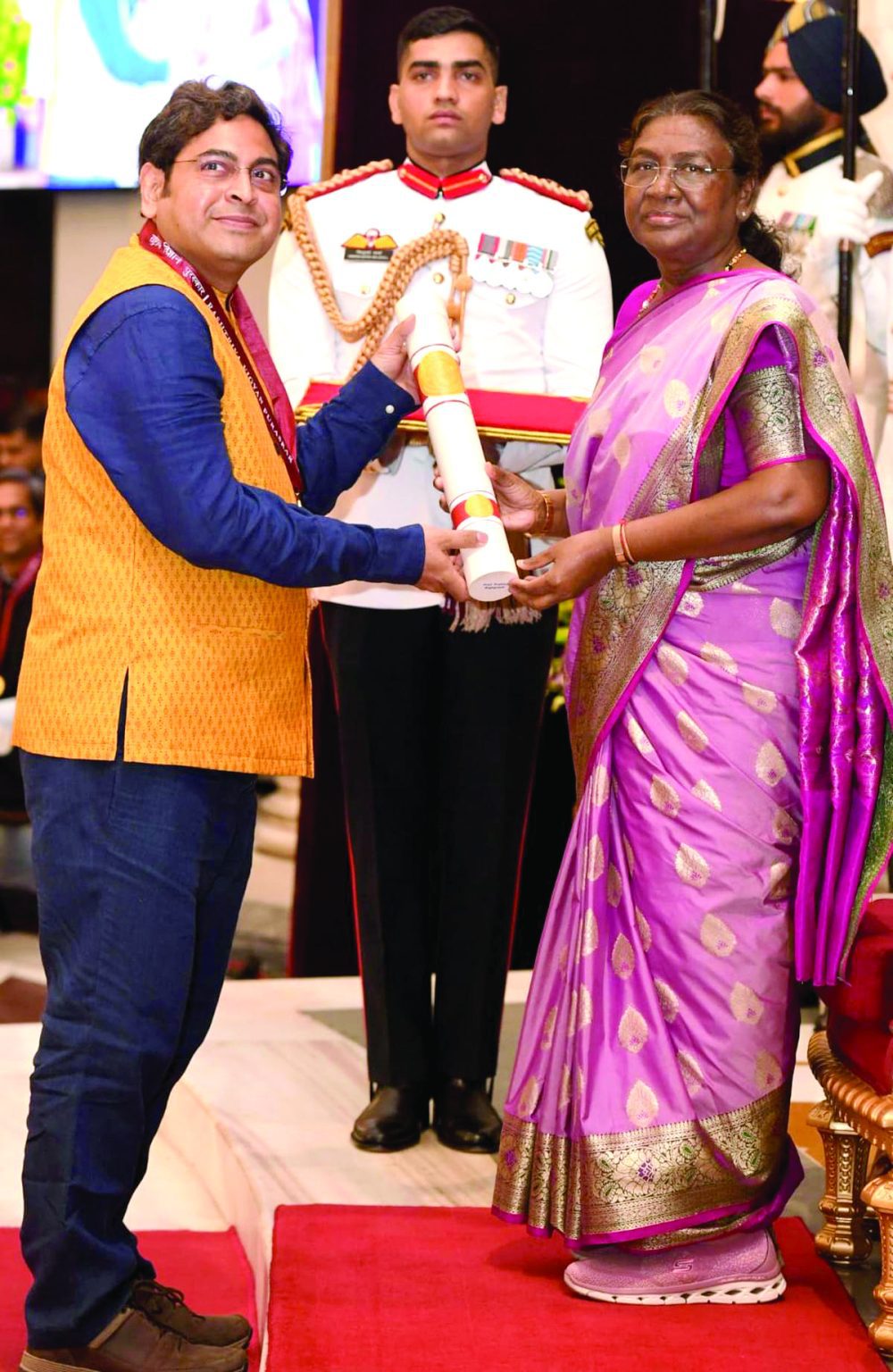Author: Science India Bureau
Italian Scientists Freeze a Ray of Light
Image Courtesy: Twitter International News We all have heard about frozen water, frozen liquid and even frozen nitrogen, which is a gas. But frozen light? Sounds like an idea from a sci-fi film! In a groundbreaking achievement, a team of Italian scientists has successfully frozen light and demonstrated that it can behave like a supersolid. This discovery, published in the Nature journal on 5 March, under the title ‘A Supersolid Made Using Photons’, marks a major leap in quantum physics. It has been described as “only the beginning” of understanding supersolidity. The research team, led by Italian physicists Antonio Gianfate…
YOUNG SCIENTIST/ PROF PRABHU RAJAGOPAL Prof Prabhu Rajagopal, a distinguished professor at the Indian Institute of Technology Madras (IIT Madras), was recently conferred with the Rashtriya Vigyan Puraskar by President Droupadi Murmu. He was awarded the Vigyan Yuva Shanti Swarup Bhatnagar Award in the newly introduced category of Technology and Innovation. This prestigious award recognises his pioneering contributions to remote assessment technologies for infrastructure assets, an area where he has combined expertise in mechanical engineering, robotics, and ultrasonic technologies to bring significant advancements. His contributions in guided ultrasonics, submersible robotics, and non-destructive evaluation (NDE) of infrastructure have not only advanced…
Image Courtesy: Wikipedia CC BY-SA 4.0/ FacetsOfNonStickPans The Union Budget 2025-26 made an important announcement of the creation of a Makhana Board in Bihar. The Finance Minister Nirmala Sitaraman in her budget speech on 1 February announced an allocation of Rs 100 crore for this initiative. “A Makhana Board will be established (in Bihar) to improve production, processing, value addition, and marketing of makhana… The Board will provide hand holding and training support to makhana farmers, and will also work to ensure they receive the benefits of all relevant Government schemes,” said the Finance Minister. Sitharaman highlighted the success of…
A Young Cyber Sentry
BUDDING INNOVATOR / RISHEEK KUMAR In December last year, when President of India Droupadi Murmu conferred the Pradhan Mantri Rashtriya Bal Puraskar 2025, one of the awardees was Jammu & Kashmir’s Risheek Kumar, the founder of the Union Territory’s first cybersecurity company, Hackers Pathshala. The achievement of the teenaged cybersecurity entrepreneur assumes importance because of his age and also because of the circumstances in which he got interested in the topic of cybersecurity. Answering questions for Science India over email, Risheek said, “I started learning about cybersecurity since I was 15 years old, after internet was restored in Jammu and…
The human genome is the ultimate instruction manual of life—a comprehensive blueprint that directs every biological process essential to our existence. Composed of DNA, which in turn is made up of four nucleotides (Adenine (A), Cytosine (C), Guanine (G), and Thymine (T)), our genetic code stretches across an astonishing three billion letters. Every cell in our body houses this intricate sequence organised within 23 pairs of chromosomes. Through the marvel of heredity, we inherit half of our genetic material from our mother and the other half from our father, ensuring that the blueprint of our life is a unique blend…
What is ‘One Day One Genome’ Mission?
India boasts of an extraordinary array of microbial diversity, with millions of microbial species yet to be discovered. To harness this vast potential, the Department of Biotechnology (DBT) and the Biotechnology Research and Innovation Council (BRIC) have initiated the ‘One Day One Genome’ (ODOG) mission. This innovative project is dedicated to showcasing and leveraging India’s microbial wealth by releasing a fully annotated bacterial genome every day. WHY ‘ONE DAY ONE GENOME’ MATTERS IN INDIA Microorganisms are essential to every aspect of our ecosystem—they drive biogeochemical cycles, shape soil formation, and significantly impact human health and agriculture. Given India’s abundant flora…
International News An exotic phase of water, called Plastic Ice VII, which defies all conventions that are known about what we understand as water and ice, has been observed by researchers at the Institut Laue-Langevin in Grenoble, France. This ice emerges under extreme conditions of 6 gigapascals pressure and temperatures of 327°C (or 620°F). This discovery was recently reported in the science journal, Nature, on February 12. This strange type of ice is known to be found deep in the oceans of distant planets such as Neptune or moons such as Europa (smallest of the four moons orbiting Jupiter). Scientists…
Dr Swarup Kumar Parida, a distinguished scientist at the National Institute of Plant Genome Research (NIPGR), New Delhi, has been honoured with the prestigious Vigyan Yuva-Shanti Swarup Bhatnagar Award in Agricultural Sciences for his groundbreaking contributions to molecular breeding and crop improvement. His research has significantly advanced the field of plant genomics, particularly in the development of high-yielding and stress-tolerant rice and chickpea varieties. Dr Parida has been at the forefront of next-generation molecular breeding for crop improvement. His work focuses on developing novel concepts and integrated genomics-assisted breeding strategies aimed at enhancing yield, plant architecture, and nutritional quality while…
In a significant breakthrough for breast cancer treatment, researchers from the Indian Institute of Technology-Guwahati (IIT-G) and the Bose Institute, Kolkata, have developed an advanced injectable hydrogel that enables localised and controlled drug delivery. This innovation not only enhances the efficacy of anti-cancer drugs but also reduces harmful side effects, marking a transformative step in oncological care. According to a statement released by IIT-G, the hydrogel acts as a stable reservoir for chemotherapy drugs, releasing them in a controlled manner specifically at the tumour site. This ensures that healthy tissues remain unharmed, a crucial advantage over conventional treatments like chemotherapy,…
VIBHA’s New HQ: A Tribute To ‘Jayant Ji’
The headquarters of Vijnana Bharati in the national capital moved to a new destination at South Extension I on 7 February. With the inauguration of its new four-storeyed office-cum-residence building — ‘Jayant Smriti’, the Vijnana Bharati enters a new phase with a plush office, reception, meeting rooms, conference hall, guest house, parking, pantry and what not. The headquarters — ‘Jayant Smriti’ — has been named in loving memory of the late Shri Jayant Sahasrabudhe, the former national organising secretary of VIBHA, who had spearheaded the relaunch of SCIENCE INDIA magazine in its new avatar in 2020. It was he who…















